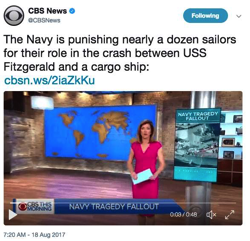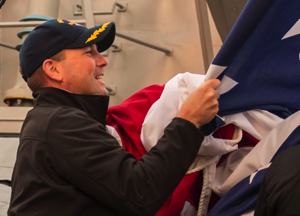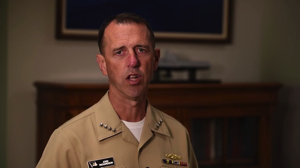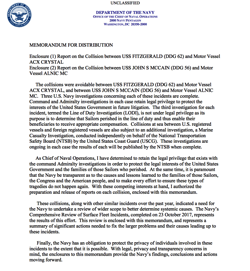Navy Releases Reports on Recent Collisions and Provides Inadequate Information and Corrective Actions

At the end of the cold war, politicians talked of a “peace dividend.” We could cut back our military funding and staffing.
Similar action was taken by the USSR Government for the Soviet fleet. I watched the Soviet Fleet deteriorate. Ships weren’t maintained. Training was curtailed. What was the second best navy in the world deteriorated. I thought it was good news.
What I didn’t know was that our fleet was deteriorating too.
Fast forward to the most recent pair of collisions involving ships in the 7th Fleet (The USS Fitzgerald and the USS John S McCain). If you read the official report (see the link below) you will see that the Navy Brass blames the collisions on bad people. It’s the ship’s CO’s and sailors that are to blame.
The blame for the ship’s leadership and crews includes (list shortened and paraphrased from the report above by me):
USS Fizgerald
- The Officer of the Deck (OOD) and bridge team didn’t follow the Rules of the Road (laws for operating ships at sea).
- The ship was going too fast.
- The ship didn’t avoid the collision.
- Radars weren’t used appropriately.
- The lookout (singular) and the bridge team was only watching the port side and didn’t see the contacts on the starboard side.
- The Navigation Department personnel didn’t consider the traffic separation lanes when laying out the proposed track for navigating the ship (and this should have been well known since this ship was leaving their home port).
- The navigation team did not use the Automated Identification System that provides real time updates on commercial shipping positions.
- The Bridge team and the Combat Information Center team did not communicate effectively.
- The OOD did not call the CO when required.
- Members of the Bridge team did not forcefully notify and correct others (including their seniors) when mistakes were suspected or noted.
- Radar systems were not operating to full capability and this had become accepted.
- A previous near-collision had not be adequately investigated and root causes identified by the ship’s crew and leadership.
- The command leadership did not realize how bad the ship’s performance was.
- The command leadership allowed a schedule of events which led to fatigue for the crew.
- The command leadership didn’t assess the risk of fatigue and take mitigating actions.
 Fired (reassigned) CO of USS Fitzgerald
Fired (reassigned) CO of USS Fitzgerald
USS John S McCain
- Then training of the helm and lee helm operators was substandard in at least part because some sailors were assigned temporarily too the ship and didn’t have adequate training on the differences in the ships rudder control systems.
- The aft steering helmsman failed to verify the position of the rudder position on his console and made a bad situation worse.
- Senior personnel and bridge watch standers on the USS John S McCain seemed to have inadequate knowledge of the steering control system.
- The ship’s watch standers were not the most qualified team and Sea Detail should have been set sooner by the Commanding Officer.
- The OOD and Conning Officer had not attended the navigation brief held the previous day that covered the risk of the evolution.
- Five short blasts were not sounded when a collision was immanent giving the other ship a chance to avoid the collision.
- The CO ordered an unplanned shift of the propulsion control from one station to another without clear notification of the bridge watch team. This order occurred in a shipping channel with heavy traffic.
- Senior officers and bridge watch standers did not question the report of loss of steering by the Helmsman or pursue the issue to resolution.
 CO & XO of USS John S McCain that were fired (reassigned).
CO & XO of USS John S McCain that were fired (reassigned).
That’s a significant blame list. Can you spot what is missing?
First, the factors that are listed aren’t root causes or even near-root causes. Rather they are Causal Factors and maybe a few causal categories.
Second, the report doesn’t provide enough information to judge if the list is a complete list of the Causal Factors.
Third, with no real root cause analysis, analysis of Generic Causes is impossible. Perhaps that’s why the is no senior leadership (i.e., the Brass – Admirals) responsibility for the lack of training, lack of readiness, poor material condition, poor root cause analysis, and poor crew coordination. For an idea about Generic Cause Analysis of these collisions and potential corrective actions, see: http://www.taproot.com/archives/59924.
Here is a short recreation of the USS Fitzgerald collision to refresh you memory…
The US Navy did not release the actual accident investigation report (the Command and the Admiralty investigations) because the Chief of Naval Operations, “… determined to retain the legal privilege that exists with the command Admiralty investigations in order to protect the legal interests of the United States of America and the families of those Sailors who perished.” I believe the release of the actual investigation reports has more to do with protecting Navy Admirals and an inadequate training and manning of US Navy ships than protecting the US Government legally.
It seems to me that the US Navy has sunk (no pun intended) to the same low standards that the Soviet Navy let their fleet deteriorate to after the cold war ended. Bad material condition, low readiness, and, perhaps, poor morale. And the US Navy seems to have the same “transparency” that the USSR had during the communist hay day.
But I was even more shocked when I found that these problems (Training, manning, material condition, …) had been noted in a report to senior US Navy leadership back in 2010. That’s right, military commanders had known of these problems across the fleet for seven years and DID NOT take actions to correct them. Instead, they blame the Commanding Officers and ship’s crews for problems that were caused by Navy and political policy. Here is a link to that report:
https://www.scribd.com/document/43245136/Balisle-Report-on-FRP-of-Surface-Force-Readiness
Why didn’t senior leadership fix the problems noted in the report? One can only guess that it didn’t fit their plans for reduced manning, reduced maintenance, and more automated systems. These programs went forward despite evidence of decreased readiness by ships in the fleet. A decreased state of readiness that led two ships to fatal collisions. This cutting of costs was a direct response to budget cuts imposed by politicians. Thus “supporting our troops” is too expensive.
It seems from the reports that the Navy would rather punish Commanding Officers and the ship’s crews rather than fix the fleet’s problems. No accountability is shared by the senior naval leadership that has gone along with budget cuts without a decrease in the operating tempo and commitments.
 Chief of Naval Operations who says these types
Chief of Naval Operations who says these types
of accidents should “never happen again.”
More blame is NOT what is needed. What is needed is advanced root cause analysis that leads to effective corrective actions. The report released by the Navy (at the start of this article) doesn’t have either effective root cause analysis or effective corrective actions. I fear the unreleased reports are no better.
What can we do? Demand better from our representatives. Our sailors (and other branches as well) deserve the budget and manning needed to accomplish their mission. We can’t change the past but we need to go forward with effective root cause analysis and corrective actions to fix the problems that have caused the decline in mission capabilities.




